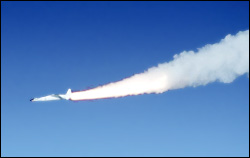NASA’s X-43A Scramjet Breaks Speed Record

Pegasus booster rocket ignites to send the X-43A on its record setting flight on Nov. 16, 2004. NASA photo <br>
X-43A research vehicle screamed into the record books again Tuesday, demonstrating an air-breathing engine can fly at nearly 10 times the speed of sound. Preliminary data from the scramjet-powered research vehicle show its revolutionary engine worked successfully at nearly Mach 9.8, or 7,000 mph, as it flew at about 110,000 feet.
The high-risk, high-payoff flight, originally scheduled for Nov. 15, took place in restricted airspace over the Pacific Ocean northwest of Los Angeles. The flight was the last and fastest of three unpiloted flight tests in NASA’s Hyper-X Program. The program’s purpose is to explore an alternative to rocket power for space access vehicles.
“This flight is a key milestone and a major step toward the future possibilities for producing boosters for sending large and critical payloads into space in a reliable, safe, inexpensive manner,” said NASA Administrator Sean O’Keefe. “These developments will also help us advance the Vision for Space Exploration, while helping to advance commercial aviation technology,” Administrator O’Keefe said.
Media Contact
More Information:
http://www.nasa.gov/missions/research/x43-main.htmlAll latest news from the category: Interdisciplinary Research
News and developments from the field of interdisciplinary research.
Among other topics, you can find stimulating reports and articles related to microsystems, emotions research, futures research and stratospheric research.
Newest articles

Bringing bio-inspired robots to life
Nebraska researcher Eric Markvicka gets NSF CAREER Award to pursue manufacture of novel materials for soft robotics and stretchable electronics. Engineers are increasingly eager to develop robots that mimic the…

Bella moths use poison to attract mates
Scientists are closer to finding out how. Pyrrolizidine alkaloids are as bitter and toxic as they are hard to pronounce. They’re produced by several different types of plants and are…

AI tool creates ‘synthetic’ images of cells
…for enhanced microscopy analysis. Observing individual cells through microscopes can reveal a range of important cell biological phenomena that frequently play a role in human diseases, but the process of…





















